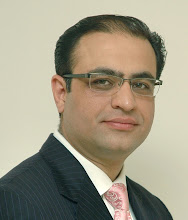The recent article on T V Santhosh that I wrote in "Graphiti", the Sunday magazine of The Telegraph newspaper reaching over a million readers...........
This week I’ve chosen to zoom in and look at one artist in the Contemporary art space — T.V. Santhosh. He’s interesting for a number of reasons but I’d have to say one of the key ones is that he’s one of the few artists to have focused on the ever-challenging relationship between India and Pakistan.
Santhosh, who has shown at many of the important global art fairs like Art Basel in Switzerland and Armory in New York among others, started focusing on imagery and the aftermath of terrorism much before any other artist in this country began using it as a visual language. He’s really been way out in front on this difficult subject.
Santhosh, who picked up his Bachelor’s degree in fine art from Santiniketan and followed it up with a Master’s in sculpture — again from Baroda’s Faculty of Fine Arts, has also got an extremely distinctive style. He paints in vibrant hues — electric green, neon yellow and shocking orange. In fact, his bold use of colour and technique is so individual that once you see one of his works, you’ll instantly recognise them in any other show.


(From top) A watercolour by the artist; An untitled work by Santhosh; Game theory by Santhosh
The danger sometimes with artists focusing on such volatile topics like terrorism is that too much negativity can creep in. Also viewers can really get tired of looking at such imagery. But these precisely are areas where this Mumbai-based artist who’s from Kerala originally is able to score. There’s no tedium. His work looks visually arresting on the wall, helped by the subtlety of expression in his works so each one stands out. His images depict chaos and paranoia relating to media coverage of contemporary events and his exploration demonstrates a reality on the verge of explosion.
Another interesting aspect about Santhosh — and it’s something I profoundly wish other top Contemporary artists would emulate — is that he’s not overly prolific. So in a year, you can expect him to produce a maximum of eight to 10 canvas works. And because he’s not churning out innumerable works, this establishes room for more demand for his works by both a good Indian collector base and the international collector fraternity.
His sculptures and installations are also quite haunting and unique but I’d have to say in terms of international recognition, they don’t even come close to his fluorescent canvas works with their deeply saturated colours and fluid edges.
On the market front, his prices have displayed an enviable sticking power — a resilience which is quite unusual in the light of the downturn in most art values. In fact, Santhosh is the only Contemporary artist whose work in the period from September 2008 to now has not gone below his primary value — in his case Rs 25 lakh for a 6ft X 4ft work.
The lowest price one of his canvases recorded in the recession was around Rs 27 lakh in the Saffronart auction last December. After that no recent canvas works have featured in any auction. This clearly demonstrated that collectors were not willing to consign any good quality works to auctions and were happy holding the work. What got offered in most of the sales were his earlier works that did not compare to the visual language he’s been using in the last three years. But what’s remarkable is that even these older works sold well above their primary prices (the gallery price).
For collectors, the good thing that his gallery, Guild Art Gallery, has done is to keep his primary prices quite attractive — for a change the primary prices are much lower than auction values.
His latest solo show in New York opened on October 14 at the well known Jack Shainman Gallery and initial reports suggested that four out of the five canvas works were already sold a week before the exhibition opened for public viewing. The primary prices were revised upward to Rs 40 lakh, which is steep but in his case, demand for his works have always outstripped supply even in recessionary times. These financial details are important because these values are high and it’s important that due diligence is exercised even if you might fall in love with one of his works.
Now, coming to a question that I have been asked quite often: how about his watercolour works that are available for a fairly affordable Rs 3 lakh to Rs 4 lakh? Well, I was never a fan of his watercolour works but I must admit that the quality of his watercolour works has gone up tremendously in the last year or so. Generally my answer would be a rule that’s critical to buying art: “Buy what you like and buy the best, look for works which are significant” and those without a doubt are his unforgettable canvas works. But as this could be a bit of a stretch, I would be tempted to collect one of his watercolour works like the one shown here (in picture) just for the brilliance of expression.
Kapil Chopra is Senior Vice President of Oberoi Hotels & Resorts.He writes a blog on collecting and investing in Indian Contemporary Art at www.indianartinvest.blogspot.com.He also writes for The Telegraph newspaper in the Sunday magazine " Graphiti" every fortnight. In Delhi, he has written for "The Mail Today " newspaper and "First City" magazine.











No comments:
Post a Comment